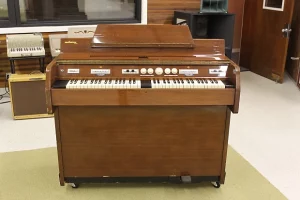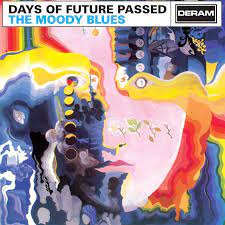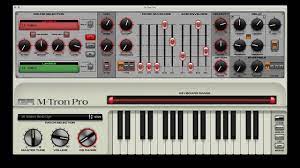Background
Based on the Chamberlin The Mellotron is an electro-mechanical, polyphonic tape replay keyboard. It was developed and built in Birmingham, England, in 1963 by the Bradley brothers who improved on the design of the Chamberlin introducing a tape-based playback system allowing it to be mass-produced more effectively.
The word Mellotron is a combination of the words “mellow” and “trombone”. The sound of the Mellotron is usually described as being warm and thick.
How the Mellotron works
 The Mellotron is a keyboard instrument that plays back sounds from analogue tapes located inside the keyboard itself. The sounds themselves are stored on these tapes that run through the instrument at a fixed speed. Each time a tone is played, it repeats exactly with no variation in pitch or amplitude. There is only one key for each tape. This design resulted in several limitations of the instrument, which were overcome in the sampler.
The Mellotron is a keyboard instrument that plays back sounds from analogue tapes located inside the keyboard itself. The sounds themselves are stored on these tapes that run through the instrument at a fixed speed. Each time a tone is played, it repeats exactly with no variation in pitch or amplitude. There is only one key for each tape. This design resulted in several limitations of the instrument, which were overcome in the sampler.
The history and significance of the Mellotron
The playback system gave the Mellotron a unique sound that was popular among musicians in the 1960s and 1970s. The Mellotron has been used by many famous bands, such as The Beatles, the opening bars of “Strawberry Fields Forever” allows the listener to experience the Mellotron doing what it does best. Creating a sound that tries to mimic but is in fact unique.
The Moody Blues iconic ” Nights in White Satin” also shows off the Mellotron in all of its glory. This track appeared on the band’s second LP “Days of Future Passed”, A concept album that fused orchestral and rock. The LP features a full orchestra and the orchestral passages are shared between the orchestra and the Mellotron. This blend gives the LP a unique sound signature. 
More progressive Rock bands introduced the Mellotron into their sound. Soon no self-respecting Prog Band would be seen without a Mellotron and the iconic sound was used to great effect on many LPs. Check out the opening of Watcher of the Skys from Genesis 1972 prog masterpiece “Foxtrot”. Rick Walkman the keyboard player from Yes also used the Mellotron to great effect notably on the LP “Close to the Edge”. Another masterpiece of Prog Rock.
Although the Mellotron was never mass-produced after 1970, it has had a few revivals by various musicians. For example, The Cranberries used the instrument on their album To the Faithful Departed in 1996. Additionally, The Flaming Lips have built up an extensive collection of Mellotrons over time.
The rise of digital audio and the Sampler, the death of the Mellotron ?
It’s fair to say that the birth of the sampler pretty much killed off the Mellotron. Sampling gave the musician so many more options. We could now create our own sounds but the sound of the Mellotron lived on becoming part of sample library’s however for many this digital sound reproduction did not capture the spirit of the Mellotron.
So did the Mellotron disappear. I’m pleased to say that it did not
The sound of the Mellotron has become so iconic, so easily imitated with modern technology, that one might think it is an instrument of the past. But not for Markus Resch.
The original Mellotrons were manufactured from 1963 to the early 1970s. In 2009, a digital version of this instrument was created by Markus Resch. The new version is called “Mellotron M4000D” and is considered a complete redesign of the original device, including hardware and software improvements. This digital version has a full polyphony of 48 notes.
There are also some very good software emulations from Companies such as G-Force and UVI.
The original M4000D was released in 2012. This version included 2GB of memory, which allowed around 60 loops to be stored in the digital frame. A larger 4GB version has since been made available, allowing up to 120 stored loops. The device also features 24-bit / 96kHz

